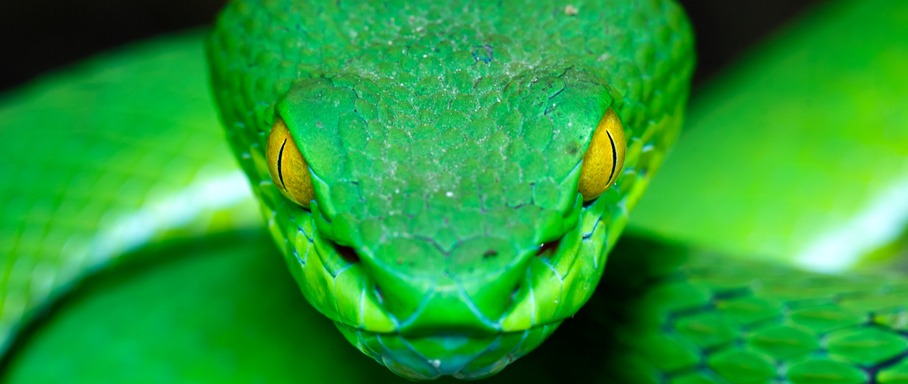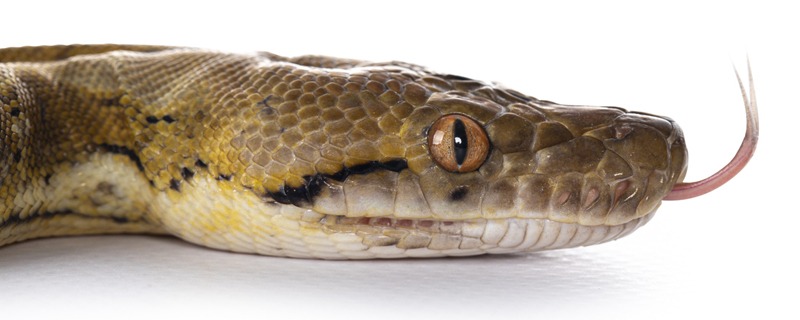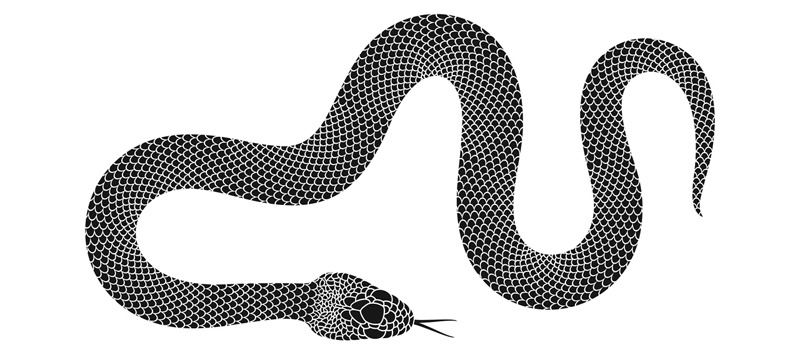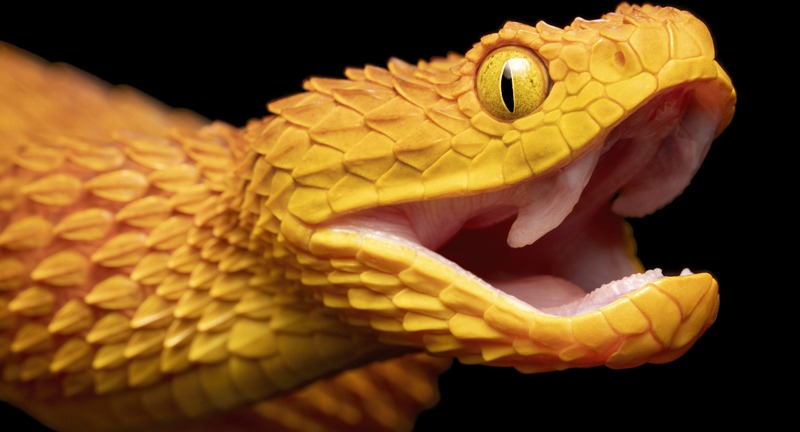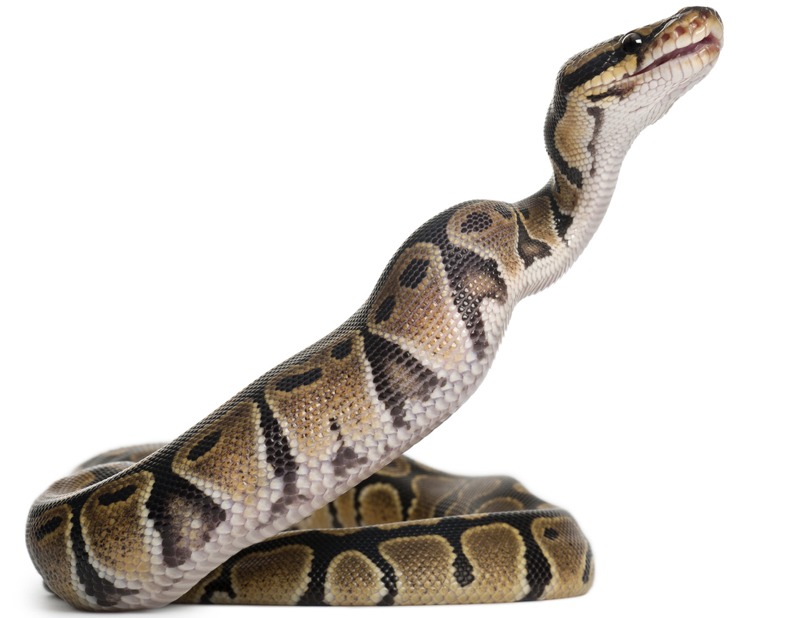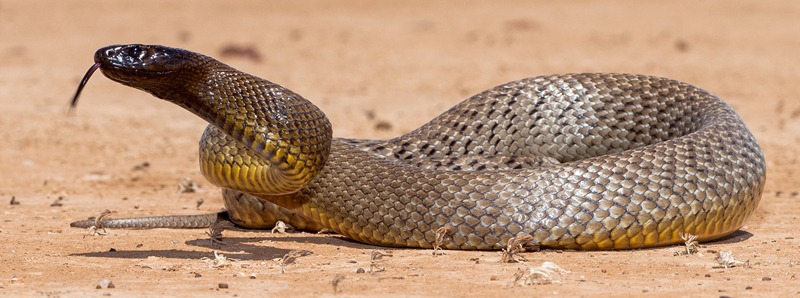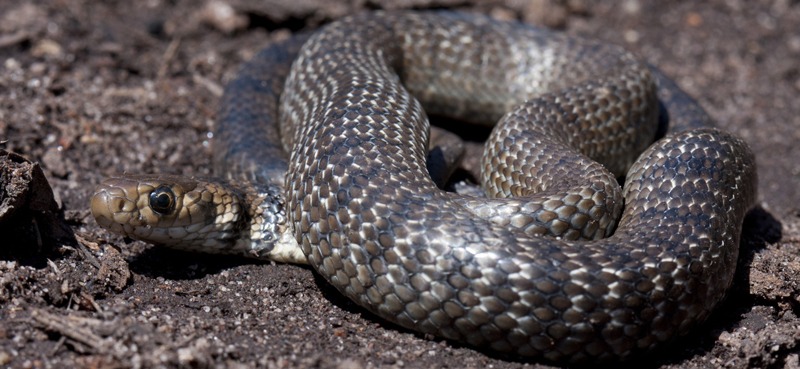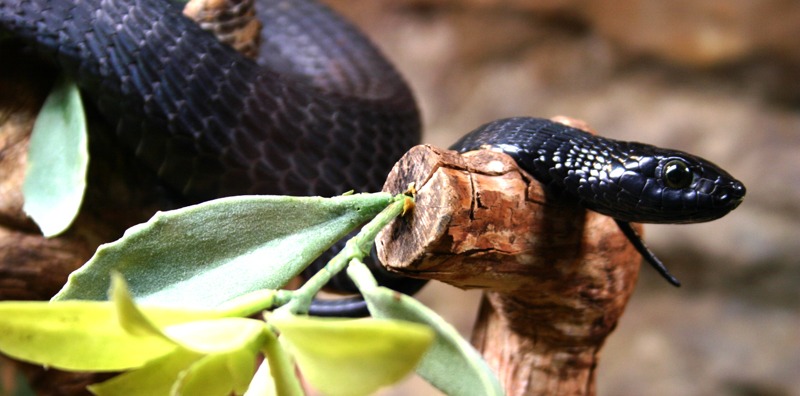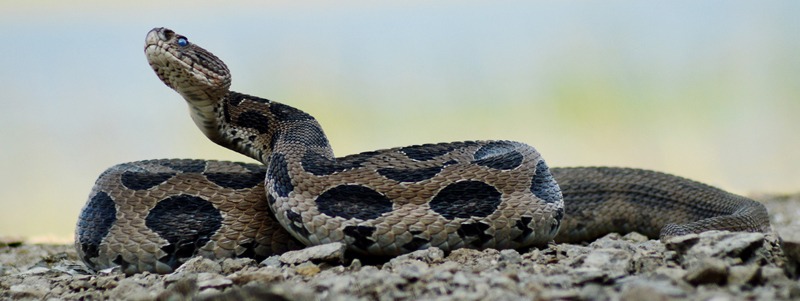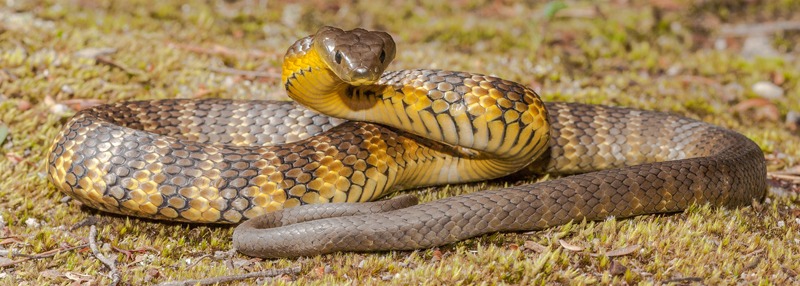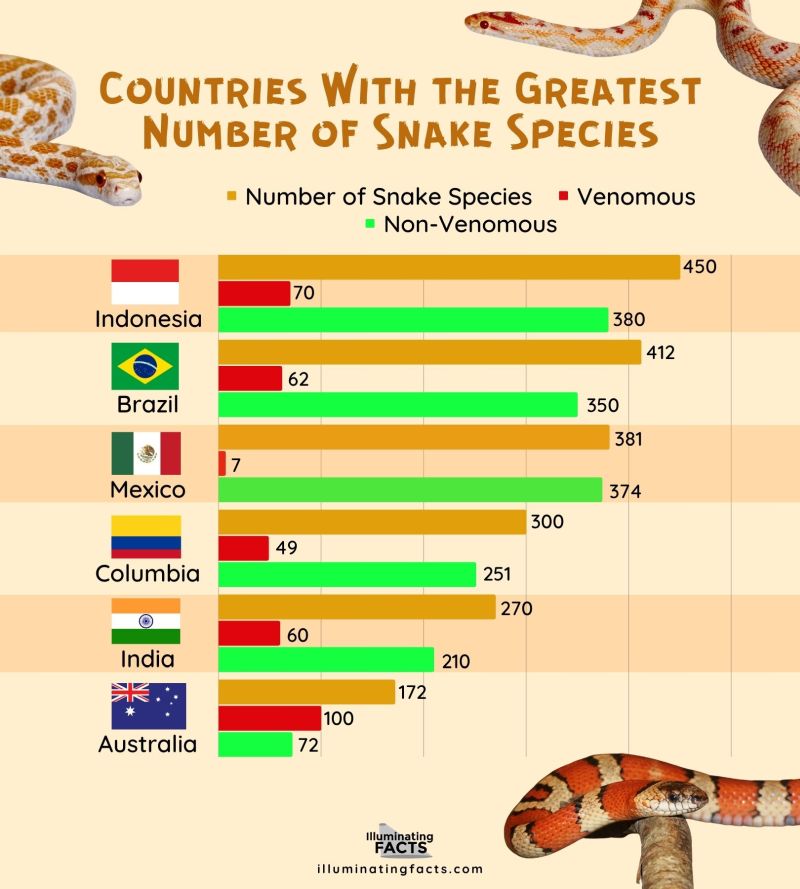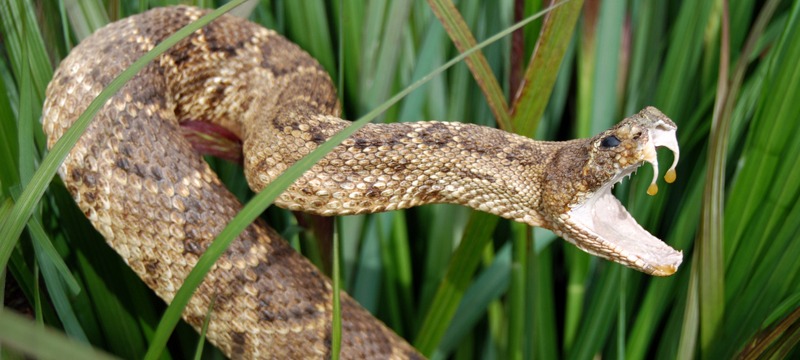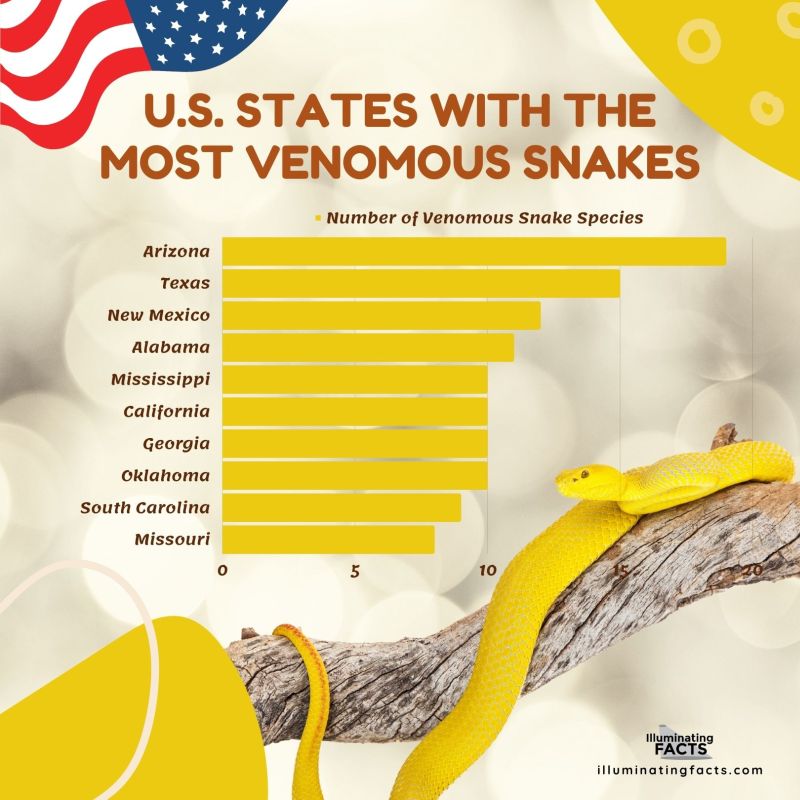Background
Among the many different animals in the world, one of the most feared is snakes. A lot of people have a fear of snakes that they can’t quite place. This is not surprising as snakes are consistently portrayed as evil figures in art, literature, and in the media. That is why most of us think that all snakes are slimy and deadly. But there are more interesting things that you can learn about snakes aside from the fact that they are scary.
Snakes are reptiles that have elongated bodies and no limbs. They also do not have any external or internal ears. Almost the whole body of a snake is covered with scales, preventing the loss of moisture from their skin. A lot of species of snakes are mysteriously colored, which protects them from predators and helps them camouflage as they hunt.
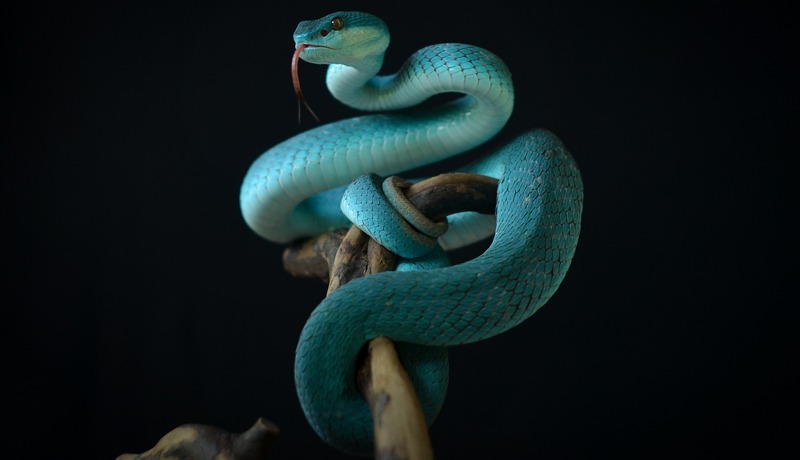
a blue snake
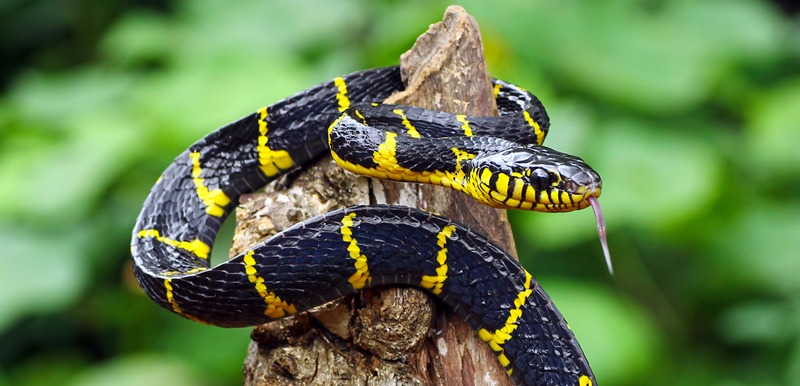
a gold-ringed snake
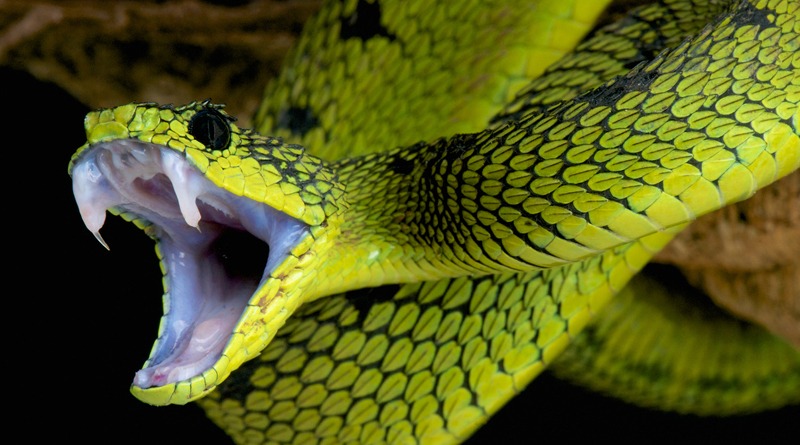
a venomous snake
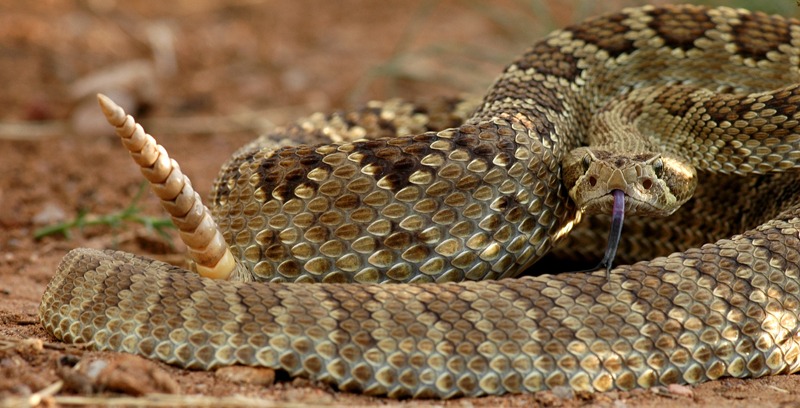
a Mojave green rattlesnake
Did you know that there are more than 3,000 species of snakes on Earth? Yes, and they are found everywhere, except in Iceland, Ireland, Antarctica, Greenland, and New Zealand. If you are looking into learning more about them, this post is perfect for you. This article contains a lot of information about snakes, including their origins and types. In addition to that, also included are different numbers about snakes, as well as the most interesting facts that you need to know about them.
Origins and Evolution of Snakes
Considering how diverse snakes are today, having around 500 genera comprising about 3,000 named species, many of us still know little about their ultimate origins. Snakes clearly evolved from their four-legged reptilian ancestors, either small, burrowing, landbound lizards or, just possibly, the family of marine reptiles referred to as mosasaurs, which appeared in the seas of the Earth about a hundred million years ago.
Why do you think snake evolution is such a lasting mystery? One of the issues is that the vast majority of snakes are small and relatively fragile creatures. Their ancestors are even smaller and even more fragile and are represented in the fossil record by incomplete remains, mostly having scattered vertebrae. There are paleontologists who have discovered presumed snake fossils dating as far back as 150 million years to the late Jurassic period. However, the traces were so evanescent as to be practically useless.
Another thing that complicates matters is the snake-like amphibian called aistopoda. They appeared in the fossil record more than 300 million years ago. The most popular genus is the Ophiderpeton. However, these were completely unrelated to the modern snakes that we know today.[1]
Ancient Snakes of the Cretaceous Period
One of the key events in snake evolution was the gradual withering away of their front and hind limbs. According to creationists, there are no such transitional forms in the fossil record. However, in the case of prehistoric snakes, they are quite wrong. It’s because paleontologists have identified no less than 4 separate genera, dating back to the Cretaceous period. They were equipped with short, imperceptible hind legs. Strangely, three of these snakes, namely Eupodophis, Haasiophis, and Pachyrhachis, were discovered in the Middle East, not otherwise a source of fossil activity. A fourth called Najash, on the other hand, lived on the other side of the world, which was in South America.
So, what do these two-legged ancestors reveal about the evolution of snakes? The answer to that is complicated by the fact that the Middle Eastern genera were found first. Since they were discovered in geologic groups that were immersed in water a hundred million years ago, paleontologists considered that as proof that snakes as a whole progressed from water-living reptiles, particularly the silky, fierce mosasaurs of the late Cretaceous period.
At the present time, the predominant view is that snakes evolved from an as-yet-unidentified land-dwelling lizard of the early Cretaceous period. It is most likely from a type of lizard called varanid. Varanids today are represented by monitor lizards, which are the largest living lizards on earth. Strange enough, then, prehistoric snakes may have been close cousins of the giant prehistoric monitor lizard called Megalania, which was about 25 feet long from head to tail and weight more than 2 tons.[1]
Giant Prehistoric Snakes in the Cenozoic Era
There were also prehistoric snakes that grew to gigantic sizes. However, the fossil evidence can, again, be inconclusive. The biggest prehistoric snake on record was the Gigantophis. It was a late Eocene monster that was around 33 feet long from head to tail and weighed about half a ton. It is classified as a madtsoiidae snake. This means that it was closely related to the prevalent genus Madtsoia.
The Gigantophis has been obscured in the record books by an even bigger genus called the South American Titanoboa. It measured more than 50 feet long and weighed as much as a ton. Oddly, it dates from the middle Paleocene epoch, which was about five million years after the dinosaurs went extinct, but millions of years prior to the evolution of mammals into giant sizes. One logical conclusion is that this prehistoric snake preyed on similarly huge prehistoric crocodiles.[1]
Common Varieties of Snakes Kept in Captivity
Snakes belong to the class Reptilia and order Squamata. The order Squamata includes suborders Serpentes or snakes and Sauria or lizards. There are around 3,00 species of snakes all over the world. Existing populations of snakes are usually divided into three classes: Scolecophidia, Alethinophidia, and Caenophidia.[2]
There are a variety of snake species that are kept in captivity. The three most common, by far, are the colubrids, boids, and pythons.
Colubrids
The colubrids are the largest and most diverse group of snakes. They have a worldwide distribution, except for Antarctica. This family includes both venomous and nonvenomous snake species. They are mostly found in aquatic, terrestrial, semiterrestrial, and arboreal habitats.
Boids
The boids, also known as boas or Boidae, are a diverse group of snakes found in fossorial, ground-dwelling, and arboreal niches from South Asia, Madagascar, the Americas, the West Indies, Central Africa, and the Southwest Pacific Islands.
Pythons
Pythons or Pythonidae were historically included in the family Boidae. However, they are restricted to the Old World, Africa, Asia, and Australia. Like boas, they may also inhabit aquatic, terrestrial, and arboreal places within their range.[2]
The Most Dangerous Snakes in the World
Around the world, many snakes are capable of causing serious harm or even death to people. Though the majority of snakes in the world are relatively harmless and can only inflict minor flesh wounds, a small number of species are quite dangerous to humans because of their aggressive behavior and powerful venom.[3]
Below are some of the most dangerous and deadliest snakes in the world based on an analysis of their overall toxicity and potential for human fatalities in case there is no medical attention or suitable antivenom.
1. Belcher’s Sea Snake
This snake is also known as the Faint-Banded Sea Snake. It is an extremely venomous snake. It has a shy and timid temperament but is considered the most venomous snake in the world. It is small and features a slender body and a yellow base with green crossbands. You can find this snake in the Indian Ocean, the Philippines, and the Gulf of Thailand. It can also be spotted in the Solomon Islands and the northwest coasts of Australia.
The Belcher’s Sea Snake is so venomous that one bite can kill a person in just 30 minutes or less. According to studies, its venom is a hundred times the strength of the Inland Taipan snake. Luckily, the Belcher’s snake has a mild manner and temperament that usually prevents it from attacking a person. Also, based on studies, this snake can control its venom release and only secretes venom in a quarter of its bites. But its venom is strong enough to kill 1,800 humans.[3]
2. Blue Krait
This snake is also called the Malayan Krait, and it is also a highly venomous snake. It has a pattern of bluish-black crossbands that are divided by yellowish-white interspaces. It is usually found in Southeast Asia. It primarily eats mice and other snakes, reptiles, and small rodents. The Blue Krait is fond of water sources and is usually spotted near lakes, ponds, and rivers. They are also nocturnal in their hunting habits.
The venom of the Blue Krait is highly potent and has powerful neurotoxins that can paralyze the victim’s muscular system. It also attacks the victim’s respiratory system, causing suffocation and inability to breathe within four hours. People may not experience pain from a krait bite, but death is common in four hours if left untreated. There is an astounding 70% to 80% of untreated mortality rates for Blue Krait bites.[3]
3. Inland Taipan
This is also a highly venomous snake that can be found in Australasia. Its venom also has high levels of neurotoxins. Just one bite can result in paralysis of the nervous system of its victim, as well as blood clots, preventing blood flow through the blood vessels. Respiratory paralysis can settle anywhere from 2 to 6 hours after being bitten.
Before the antivenom for the Taipan’s venom was developed in 1956, only two people were reported to have survived the snake’s bite. However, the window of use for the antivenom is fairly small. Therefore, getting medical help immediately is important.[3]
4. Eastern Brown
This snake can be found in all environments around Australia, except for dense forests. They are commonly spotted on farms because their main prey is the populous house mouse. The Eastern Brown is an extremely deadly snake due to its potent venom. It is the reason behind more deaths in Australia than other snake species. In fact, according to the University of Melbourne, out of the 35 reported snake-bite deaths from 2000 to 2016 in Australia, 23 were caused by the Eastern Brown snake.
However, the mortality rate from bites from this snake is fairly low, just 10% to 20%, as the snake does not deliver a high volume of venom with each bite. Depending on the amount of venom injected during the bite, some people have been known to develop extreme symptoms in just two minutes. Though there is an antivenom, the fast onset of the symptoms often negates its benefits. Victims usually slip into cardiac arrest before the right care can be provided.[3]
5. Black Mamba
This species of extremely venomous snake can be found in Sub-Saharan Africa. It loves both on the ground and in trees. It is popular for its average length of about 6.6 feet to 10 feet. Unlike other snakes, the Black Mamba delivers multiple bites when it strikes. Its venom can induce symptoms in just 10 minutes, making it fatal if antivenom is not given rapidly.
The venom of the Black Mamba can cause severe tingling, drooping eyelids, metallic taste in the mouth, blurred vision, and paralysis of the respiratory system. People bitten by this snake can die in 30 minutes to 3 hours after injection if medical treatment is not provided fast. Also, the antivenom for this is not widely available in the rural areas of Africa. That is why deaths caused by it are still frequent.[3]
6. Russell’s Viper
This snake is also called the Chain Viper. It produces a considerable amount of venom in each bite, highly lethal to humans in doses of 40 to 70 milligrams. Its bite can cause excessive bleeding, rapid drop in blood pressure, necrosis, vomiting, kidney failure, and blood clotting.
An antivenom is relatively effective against Russell’s Viper. However, the pain from the bite can last for four weeks and cause severe tissue damage. About 29% of people who survived its bite also suffer damage to their pituitary glands.[3]
7. Tiger Snake
This is also a highly venomous snake found in the southern part of Australia and Tasmania. Its venom is composed of coagulants, neurotoxins, myotoxins, and hemolysins. Its bite can cause extreme foot and neck pain, numbness, sweating, difficulty in breathing, and paralysis. But there is an effective antivenom provided that it is given to the victim on time. There is a nearly 60% mortality rate for untreated Tiger Snake bites. In 119 bites, 4 people died from complications.[3]
8. Death Adder
The Death Adder has a highly toxic neurotoxin in its venom. Its bites can result in death in just six hours if left untreated. Like the other snakes on this list, its venom can cause paralysis and complete respiratory shutdown. There is an antivenom for Death Adder bites. However, deaths still occur as the antivenom can only slow down the progression of symptoms to a degree.[3]
9. Philippine Cobra
This is also known as the Northern Philippine Cobra. It is a quite stocky snake species with a hood that can be raised when threatened. Its venom is composed of postsynaptic neurotoxin that affects the respiratory system of its victim directly, as it is extremely potent. Some of the symptoms of its bite include migraines, nausea, vomiting, dizziness, abdominal pain, and difficulty in breathing. Symptoms can appear in just 30 minutes.
There are treatments available to alleviate the venom. However, they are not always successful, resulting in death. The Philippine Cobra also has the ability to spit its venom at potential victims, which can cause serious damage to the eyes if hit, and may even cause permanent blindness.[3]
10. Mojave Rattlesnake
This snake is called the Mojave Green, a highly venomous pit-viper species. It has an extremely deadly venom that matches King Cobra’s and Black Mamba’s toxicity. Its bites usually have delayed symptoms, prompting its victim to underestimate the severity of the bite. But muscle weakness, vision problems, and difficulty speaking can occur within hours.
Even though the Mojave Rattlesnake has potent venom, fatalities from it are relatively rare due to the popularity of CroFab antivenom. It is a highly effective antivenom for counteracting the effects of the snake’s bites.[3]
Countries That Have The Greatest Number of Snakes Species
Across the world, there are about 3,570 snake species. But among those snake species, only 600 are venomous. Even among the venomous ones, only 300 species have enough venom to kill a person.[4] However, many people are still afraid of snakes, maybe due to the movies they have watched.
Below are the top six countries that have the greatest number of snake species in the world:
1. Indonesia
Indonesia is home to different venomous snakes. Its dense forests provide them a safe space to flourish. The country also has diverse landscapes and untouched forests, which are the perfect home for snakes like kraits, vipers, and cobras. The coral reefs of Indonesia are also home to some of the most venomous snakes in the world.
2. Brazil
Brazil has one of the densest forest areas in the world, giving protection and habitat to many snake species. It is home to various types of vipers and coral snakes. There is an island in Brazil called Ilha da Queimada Grande, which is full of snakes. The government prohibited people from entering the island due to the numerous venomous snakes. According to researchers, there is about one snake per square meter on this island.
3. Mexico
Many people might be surprised to learn that many snakes exist in Mexico. It is home to some of the most venomous snakes in the world. There are about 80% of snake species in this country. These include rattlesnakes, coral snakes, and pit vipers.
4. Colombia
Colombia is also home to highly venomous snakes, such as coral snakes and pit vipers. But there are also many non-venomous but dangerous snakes here, such as boas and pythons.
5. India
India is popularly known to be home to most species of snakes from the Cobra family. The Indian cobra and the King cobra flourishes in various parts of the country.
6. Australia
Australia is home to the most venomous and dangerous snakes in the world. It has around 100 different venomous snake species. In fact, according to studies, Australians encounter snakes more often than most other countries in the world. But even though the snake species in Australia are venomous, they are not that aggressive, making the snake bite rate in the country not too high.[4]
Countries Without Snakes?
While some countries are home to the greatest number of snake species, there are also quite a few countries across the globe that don’t have snakes. These places have one thing in common – they are all islands. In addition, some far-flung parts of the continents are too cold for snakes to endure. Iceland, Ireland, and New Zealand are the three biggest countries that do not have snakes.[5]
Ireland
About 150 million years ago, snakes started appearing in the fossil record. However, Ireland was far removed from any other landmass during those times. Therefore, snakes did not have any way to get there. Also, back then, Ireland was much colder than it is at present. Even though scientists think there may have been a land bridge between England and Ireland after the last ice age, snakes never crossed it for whatever reason. Maybe it’s because primitive Ireland was too cold for them.[5]
New Zealand
The country of New Zealand is isolated from any other country geographically. It would take a lot of effort for snakes in Australia to get to New Zealand. It can be possible for snakes to go to new habitats by crossing the sea by swimming or by being taken by the current. However, the distance between New Zealand and Australia is just too big. The NZ Department of Conservation says that even sea snakes rarely visit the country. They only pass by when the water is too cold and outside their tropical range.[5]
Iceland
This is also an example of a volcanic island that has never been connected to another continent. Since it is surrounded by the coldness of the Atlantic Ocean, snakes are unable to swim across either North America or the United Kingdom.[5]
In addition to these countries, other parts of the world that do not have snakes include Siberia, Greenland, Antarctica, Central and Northern Canada, the southern tip of Argentina and Chile, and the northern part of Finland.[5]
Venomous Snakes in the United States
There are about 150 species of snakes that are native to North America. Among those, 20 are venomous, distributed unevenly throughout the continent. The venomous snakes in the United States are divided into four main groups: rattlesnakes, copperheads, cottonmouths, and coral snakes. These species include many regional varieties and subspecies, but all of them belong to pit vipers of the Viperidae family, excluding coral snakes from the Elapidae family.
- Rattlesnakes: Most of the pit vipers in the United States are rattlesnakes. These are the largest venomous snakes in the United States, with 16 species. The most venomous are the tiger rattlesnake and the Mojave rattlesnake, both of which can kill a human.
- Copperheads: These are medium-sized snakes that are usually found in the eastern United States in both terrestrial and semi-aquatic habitats. They have a coppery pink or reddish-brown color.
- Cottonmouths: These are semi-aquatic snakes that are usually found around bodies of water and humid places.
- Coral Snakes: These snakes inhabit different environments, such as rocky areas, forests, and flooded plains. They are also very common in urban areas. That’s why they are present in most states with the most venomous snakes in America. If you come across a red, yellow, and black snake, knowing this phrase will help you determine if it is poisonous: Red touch yellow, kill a fellow; red touch black, friend of Jack.
States in America with the Most Venomous Snakes
Snakes are mostly found in regions with a warmer climate where they live in different ecosystems, from rainforests to deserts. Venomous snakes are present in almost all the states in America, except Hawaii and Alaska, where no native snake species are found. Florida is the U.S. state with the greatest number of snake species. However, it is not among the states with the most venomous snakes.[6] Below are the ten US states having the most venomous snakes.
1. Arizona
Here are the most common venomous snakes that can be found in Arizona:
- Animas ridge-nosed rattlesnake
- Arizona black rattlesnake
- Banded rock rattlesnake
- Colorado desert sidewinder
- Desert massasauga
- Grand Canyon rattlesnake
- Great basin rattlesnake
- Hopi rattlesnake
- Mojave desert sidewinder
- Mojave rattlesnake
- Northern black-tailed rattlesnake
- Prairie rattlesnake
- Sonoran desert sidewinder
- Southwestern speckled rattlesnake
- Tiger rattlesnake
- Western diamondback rattlesnake
- western twin spotted rattlesnake
2. Texas
Here are the most common venomous snakes that can be found in Texas:
- Banded rock rattlesnake
- Broad-banded copperhead
- Desert massasauga
- Mojave rattlesnake
- Bottled rock rattlesnake
- Prairie rattlesnake
- Southern copperhead
- Texas coral snake
- Timber rattlesnake
- Trans-Pecos copperhead
- Western cottonmouth
- Western diamondback rattlesnakes
- Western massasauga
- western pygmy rattlesnake
3. New Mexico
Here are the most common venomous snakes found in New Mexico:
- Rock rattlesnake
- Western diamondback rattlesnake
- Prairie rattlesnake
- Mojave rattlesnake
- Black-tailed rattlesnake
- Massasauga
- Ridge-nosed rattlesnake
- Sonoran coral snake
- Arizona black rattlesnake
- Banded rock rattlesnake
- Mottled rock rattlesnake
- New Mexico ridge-nosed rattlesnake
4. Alabama
Here are the most common venomous snakes found in Alabama:
- Carolina pygmy rattlesnake
- Dusky pygmy rattlesnake
- Eastern cottonmouth
- Eastern coral snake
- Eastern diamondback rattlesnake
- Florida cottonmouth
- Northern copperhead
- Southern copperhead
- Timber rattlesnake
- Western cottonmouth
5. Mississippi
Here are the most common venomous snakes found in Mississippi:
- Southern copperhead
- Western cottonmouth
- Eastern cottonmouth
- Canebrake rattlesnake
- Timber rattlesnake
- Carolina pygmy rattlesnake
- Dusky pygmy rattlesnake
- Eastern diamondback rattlesnake
- Western pygmy rattlesnake
- Eastern coral snake
6. California
Here are the most common venomous snakes found in California:
- Colorado desert sidewinder
- Great basin rattlesnake
- Mojave desert sidewinder
- Mojave rattlesnake
- Northern Pacific rattlesnake
- Panamint speckled rattlesnake
- Red diamond rattlesnake
- Southern Pacific rattlesnake
- Southwestern speckled rattlesnake
- Western diamondback rattlesnake
7. Georgia
Here are the most common venomous snakes found in Georgia:
- Carolina pygmy rattlesnake
- Dusky pygmy rattlesnake
- Eastern coral snake
- Eastern cottonmouth
- Eastern diamondback rattlesnake
- Florida cottonmouth
- Northern copperhead
- Southern copperhead
- Timber rattlesnake and western cottonmouth
8. Oklahoma
Here are the most common venomous snakes found in Oklahoma:
- Desert massasauga
- Prairie rattlesnake
- Timber rattlesnake
- Western diamond rattlesnake
- Western massasauga
- Western pygmy rattlesnake
9. South Carolina
Here are the most common venomous snakes found in South Carolina:
- Carolina pygmy rattlesnake
- Dusky pygmy rattlesnake
- Eastern coral snake
- Eastern cottonmouth
- Eastern diamondback rattlesnake
- Florida cottonmouth
- Northern copperhead,
- Southern copperhead
- Timber rattlesnake
10. Missouri
Here are the most common venomous snakes found in Missouri:
- Eastern massasauga
- Northern copperhead
- Osage copperhead
- Southern copperhead
- Timber rattlesnake
- Western cottonmouth
- Western massasauga
- Western pygmy rattlesnake
Interesting Facts About Snakes
If you want to learn more about snakes, below are some of the most interesting facts that will blow your mind.
- A total of 3,868 species of snakes worldwide have been discovered and recorded.
- Snakes are ectotherms. This means they can’t create body heat on their own. They are cold-blooded creatures that rely on the outside temperature to get energy. When warmed up, they have the energy to go about their day or night.
- Snakes are carnivorous, unlike other reptiles like lizards. This means that snakes only eat meat or animal eggs.
- Snakes can slither or slide 12.5 miles per hour. Even though they do not have limbs, they move surprisingly fast.
- There are about 1.1 million people in the world that own pet snakes.
- As the temperature cools, snakes seek refuge and shelter to hibernate. They usually do this in old animal burrows, fallen logs, or other manmade structures.
- Snakes do not have lips, but they can drink water. They use their mouths to suction water into their throats.
- Snakes can survive without eating for months. They have the ability to limit their resting energy consumption as they are cold-blooded. Therefore, they can avoid digesting their vital stores of protein needed to survive.
- Snakes have teeth that are usually small and curved. These allow them to get a good grip on their prey. Many also have fangs that are longer and sharper compared to their teeth. This varies by species.
- You may also wonder why snakes hiss. They do this as a defense mechanism. When disturbed, they will first try to slide away and find cover. If they fail, they will hiss and curve their bodies or strike. This is a way to let their attacker know that they will strike.
- Reticulated pythons can grow as long as 33 feet, the longest in the snake world. They can eat bears, deer, and wild hogs with their size.
- The smallest snake in the world is the Barbados thread snake. It is just 10 centimeters.
- Snakes are venomous and not poisonous.
- The most venomous snakes in the world are Inland Taipans. Other highly dangerous snake species are Cobra and Black Mamba.
- Snakes lack eyelids. Their eyes are protected with a pair of modified scales called eye caps. These repel dust from their corneas and maintain moisture.
- Snakes are diurnal, nocturnal, and crepuscular. This is why it is possible to find snakes out and about at all times of the day and night.
- The type of meat snakes eat varies by species. For example, rat snakes eat almost anything they can catch and swallow, while tentacled snakes pose as underwater branches and eat fish. Therefore, when keeping snakes in captivity, it is essential to know what type of food they eat in the wild.
- Snakes can hear even without external ears. They have internal ear bones that are remnants of their origin as lizard-like animals. With these, they can detect sound vibrations traveling through the ground and notice sounds traveling through the air.
- Snakes smell the air to hunt by flicking out their tongues. They have a Jacobson’s organ located on the roof of their mouth. This lets them pick up scent molecules gathered by their tongues. Other snakes like pythons, vipers, and boas have special pit organs above their mouths to see the heat coming off of an animal or surface.
- Snakes have unique skeletons. Most of their length is their torso, with ribs attached to a flexible spine. This means that snakes are not all tails. Only a small part of their body is a real tail.
- Snakes shed their skin two to three times a year. Before they shed, their scales appear dull, and their eyes become opaque. This is due to the top layer of their skin separating from the layers beneath. When they are ready to shed, they rub on rough objects to remove the unwanted skin.
- Most snakes lay eggs, but there are some species, such as sea snakes, that give birth.
- Sea snakes can breathe partially through their skin, allowing them to stay underwater longer.
- Snakes have poor eyesight. If you stand still before a snake, you might be mistaken for a rock or a tree.
- Snakes’ scales contain keratin, the same substance found in human hair and nails. They are also sensitive and can feel pain.
Conclusion
Snakes are truly unique and interesting animals. They come in all types of shapes, colors, and sizes. They are also among the most popular pets as more than five hundred thousand households in the United States own a pet snake. Many types of snakes are indeed scary, particularly the most venomous ones. But many are also harmless, as long as humans let them do their own business. We hope this article helped you learn more about snakes.
References
[1] Strauss, B. (2019, June 20). The long, slithering story of snake evolution. ThoughtCo. Retrieved January 26, 2022, from https://www.thoughtco.com/prehistoric-snakes-story-of-snake-evolution-1093302
[2] Ossiboff, R. J. (2018). Serpentes. Serpentes – an overview | ScienceDirect Topics. Retrieved January 26, 2022, from https://www.sciencedirect.com/topics/agricultural-and-biological-sciences/serpentes#:~:text=Snakes%20are%20listed%20in%20the,Scolecophidia%2C%20Alethinophidia%2C%20and%20Caenophidia.
[3] Slawson, L. (2019, May 3). The top 10 deadliest and most dangerous snakes in the world. Owlcation. Retrieved February 4, 2022, from https://owlcation.com/stem/Top-Ten-Deadliest-Snakes-in-the-World
[4] Mine, T. (2021, June 22). Which country has the most snake’s species? (most poisonous and snakeless). Petrapedia. Retrieved February 4, 2022, from https://petrapedia.com/which-country-has-the-most-snakes-species/
[5] Carter, L. (2020, December 15). Where are there no snakes in the world? Snakes for Pets. Retrieved February 4, 2022, from https://www.snakesforpets.com/where-are-there-no-snakes-in-the-world/
[6] Kimalainen, S. (2017, April 21). 10 states with the most venomous snakes in America. Insider Monkey. Retrieved February 4, 2022, from https://www.insidermonkey.com/blog/10-states-with-the-most-venomous-snakes-in-america-575437/
[7] David, J. (2021, June 22). 23 fun and interesting snake facts and statistics. Everything Reptiles. Retrieved February 4, 2022, from https://www.everythingreptiles.com/21-snake-facts/
[8] PETA, E. (2021, July 16). 15 facts about snakes – blog. PETA India. Retrieved February 4, 2022, from https://www.petaindia.com/blog/15-facts-about-snakes/

